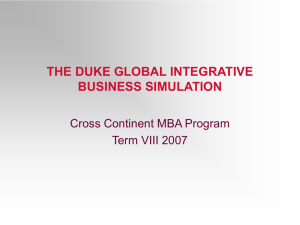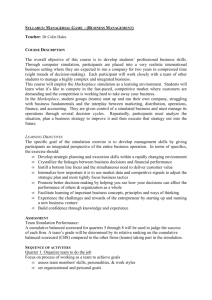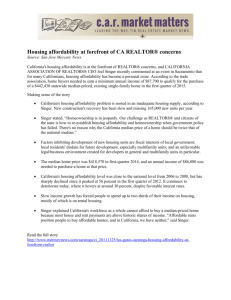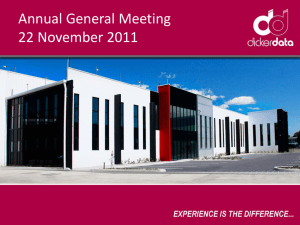simulation-intro-g06 - Duke University`s Fuqua School of Business
advertisement
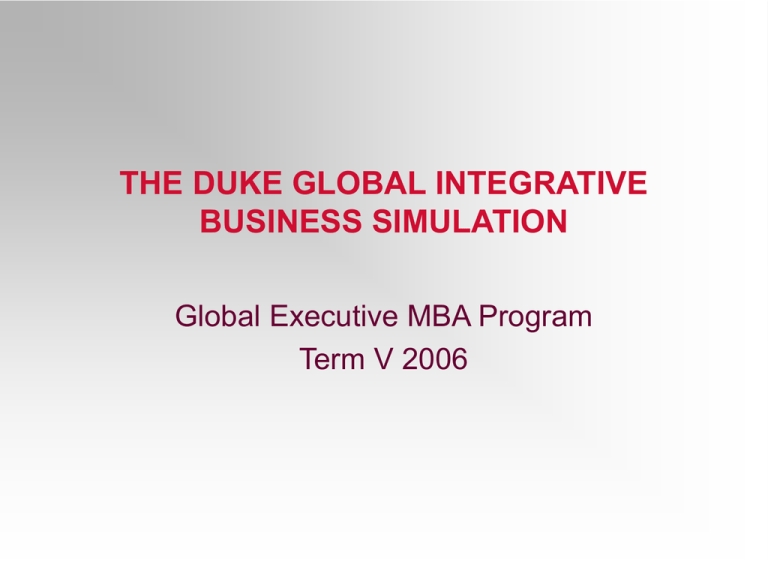
THE DUKE GLOBAL INTEGRATIVE BUSINESS SIMULATION Global Executive MBA Program Term V 2006 Agenda Objectives Mechanics Market Information and Decisions Part I: Objectives Duke Global Integrative Business Simulation A competitive business simulation focused on strategy formulation & implementation A capstone learning experience that integrates learning from the core curriculum requires the design and execution of a strategy demands good decision making under uncertainty Tests your ability to build and maintain an effective team integrate functional decisions to achieve company goals deal effectively with unexpected events Part II: Mechanics Two Worlds Blue World and Red World Each with six teams Teams compete within a world List of teams available Each world has a wing in Thomas Center, each team with an office (a team room) Software will be loaded before you occupy your office Decisions Beginning: Strategy Planning Worksheet Present it to a venture capitalist group Quarter 0 start-up decisions about plant locations and size Quarters 1~? Decisions Shareholder meeting Final Presentations Communications We communicate with you by memos and handouts You cannot talk to any member of any of your competing teams You can talk to instructor and facilitators You can give out Press Releases We also publish Duke Street Journal Facilitators A group of facilitators help me run the simulation Dedicated team for each world Part III: Market Information and Decisions How Do You Succeed? Competitive results are based on the interactions of: Customers’ demand characteristics Competitors’ and company decisions Economics in the environment Unknowns ?? There are many decisions, each involves tradeoffs Customers 24 Unique Customers 15 Wholesalers 9 Retailers Needs differ by customer type Demand forecast by customer Industry Demand Initial Demand 10,000 ? 0 Capacity ? Forecast Forecast for Strong Growth Initial Market Sizes South America 20% Asia 22% North America 31% Europe 27% Sources of Competitive Advantages Price Product Improvements Reliability Sales Support Delivery Advertising Geographic or Customer Focus Branding Strategy Plant Location Multiple Functional Decisions Marketing Sales Finance Operations R&D Some decisions about the present, others about the future Assessing Your Situation Your situation at a given stage is given by: Your financial statements balance sheet, income statement, cash flow statement Available inventory, production capacity Number and locations of sales offices and salesforce available Product features amount of pre-approved loans available Improvement level, reliability, variable costs Customer satisfaction levels Marketing Decisions Sales Decisions Sales Offices Must have open to sell in an area Each office costs $10,000 / qtr; $5,000 start-up Turnover caused by poor financial results and/or poor customer service Operations Decisions Building plants Production Capacity choices, plant locations $25k/site, $125/unit of capacity How to much to product from the available capacities Lead time in the process How much to distribute from where to where Finished goods supplier available Produces to your specification Available in the same period Construction, Production and Sales Quarter X Construct Quarter X+1 Produce & Store in Regional Warehouse Quarter X+2 Distribute/Sell Operations Decisions Screen Key Production/Operations Costs Initial Variable Costs Fixed Costs Capacity Fixed Costs up to 1000 units $15,000 1001…3000 25,000 3001…5000 35,000 more than 5001 40,000 Region North America South America Europe Asia Variable Costs $85/unit 79 75 81 Distribution Costs One region to another: $7/unit Retrofitting costs for regional brand shipped to another region: $10/unit R & D Decisions Product Improvements Pricing Flexibility Cost Reduction Variable Costs Process Engineering Reject Rate/ Reliability R&D Product Improvement Decisions Highly uncertain results from expenditures Limited to 1 product improvement per quarter First product improvement should cost between $20K to $30K Each subsequent expenditure is less effective in increasing product improvement Expenditures for global brands more effective than for regional brands Expense item Other R&D Decisions Cost Reduction (Capitalized) Process Engineering (Expensed) Investment is unique to each plant Highly uncertain process $10K – $15K for 1% reduction in reject rate Each additional reduction harder to achieve $10K to $15K per plant to reduce initial unit variable cost by $2 to $5 Each subsequent dollar is less effective R&D Decisions Screen Finance Decisions Long-term Debt (Planned) Short-Term Debt (Planned) Must be scheduled Issuing charges Automatically renewed Interest rate 1% higher than short-term debt Must maintain debt/equity ratio below 100% to issue 10-year maturity Issuing charges Interest rate depends on credit rating (prime rate plus risk premium) Bank intervenes if D/E > 100% Finance Decisions Screen Importance of Cash Flow Management Solvency Loan (Emergency) Automatically granted Fee: $10,000 Interest rate about 6% above prime rate Automatically converted to short-term debt next quarter Managing Cash Flow Cash Balance Debt Accounts Receivable Available Cash Operating Expenses Capital Expenditures Interest Managing Foreign Exchange Not a learning objective All transactions in US dollars Strategy Creates Alignment Finance R&D Marketing Sales Operations Initial Company Position Customers Perceive Companies as Equals $700K Cash AAA Debt Rating Finance R&D All Companies at Same Position Marketing Sales Operations All Companies Face Start-Up Decisions • Plant Location • Production Levels • Plant Capacity Three Experienced Sales Reps Start-Up Decisions $700K in available cash Key decisions Locations of plants Capacities of plants (1,500 total) Production for Quarter 1 Suggestions for Success Make your strategy the centerpiece of your thinking If uncertain about a decision Check the case facts from the manual Ask about it There is a person behind every piece of paper Use all your instincts, judgment, and experience React to information/events as you would in your real job Logistics Headquarters / External Environment Handouts Deadlines, Late Penalties: $1,000 per minute Give yourself the time to enter the decisions and verify them Each quarter: turn in your memory key + a hard copy; Our version of Sarbanes-Oxley: hard copy must be signed by the CEO Next Steps Make sure everyone is prepared Read the simulation guide/manual, take the quiz You will begin by filling out a specific strategy planning worksheet I will also ask you to agree on a decision making process Caution This simulation is a very good learning experience It is not a game but is a simulation The objective is not to do slightly better than the competitors but is to put the company on a sound footing It is a lot of fun BUT It can also be very stressful Maintain the right balance GOOD LUCK!
